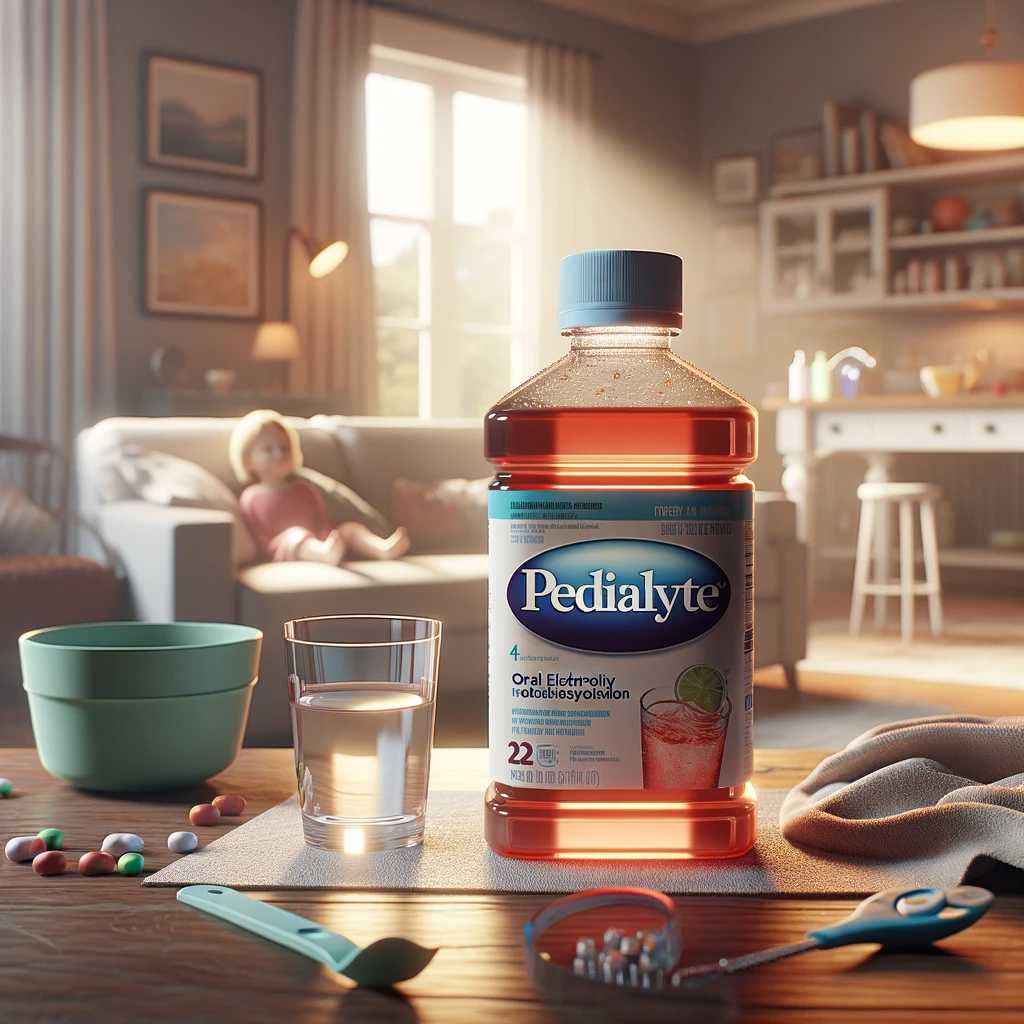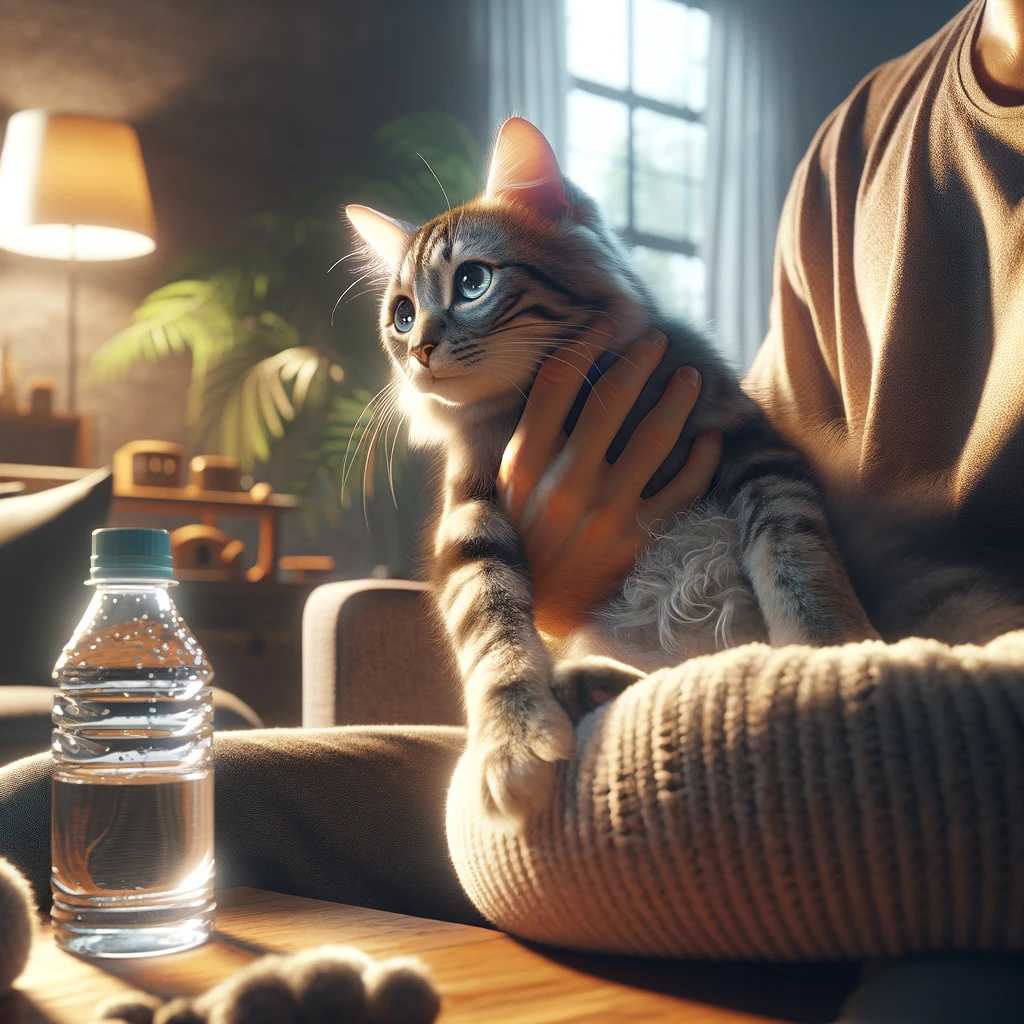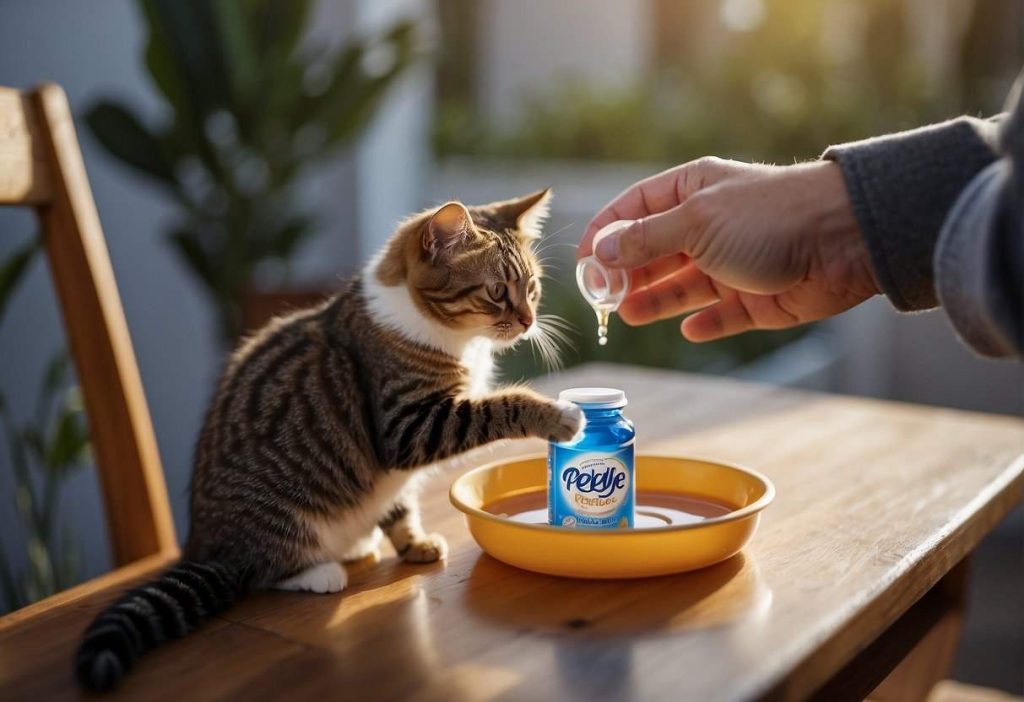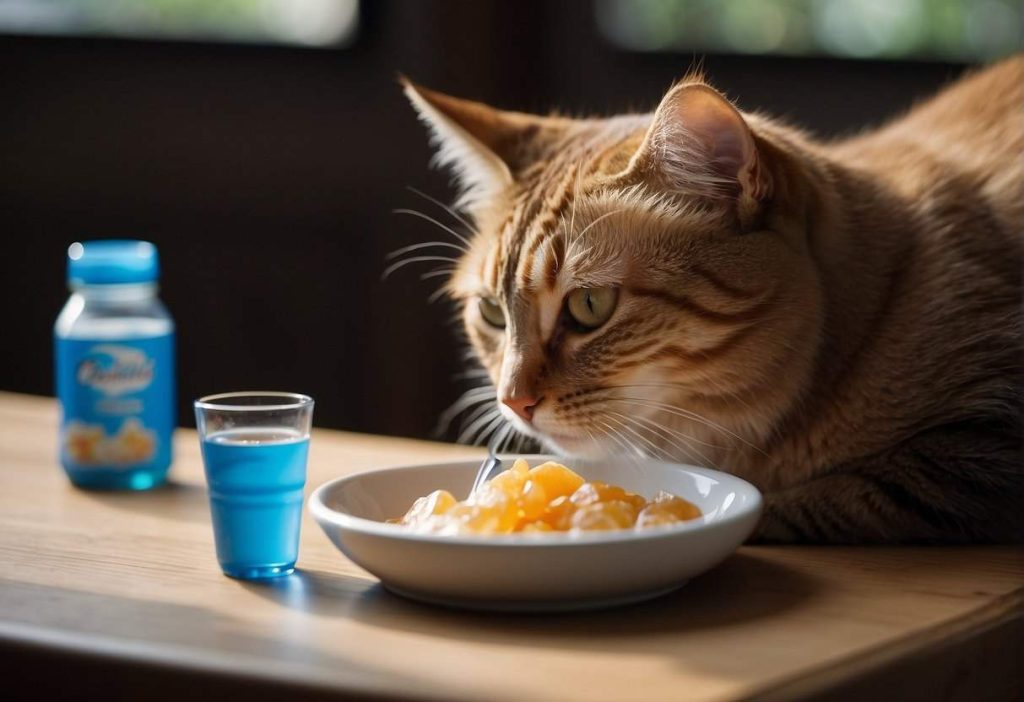Is Pedialyte for cats a hydration solution or a potential danger?
Maintaining proper hydration is crucial for your feline friend’s overall health and well-being.
Just like humans, even a healthy cat can experience dehydration, which can lead to a host of problems if not addressed promptly.
Dehydration in cats is often a result of conditions such as diarrhea or vomiting, and rehydration becomes imperative to their recovery. (1)
In such situations, you might be considering Pedialyte, a common rehydration solution used by humans, as a way to ensure your cat replenishes the essential electrolytes it might have lost, especially in mild cases of dehydration.

Pedialyte is specially formulated to provide the perfect balance of sugar and electrolytes needed for effective hydration. (2)
When your furry companion is under the weather and not drinking enough water, Pedialyte can step in as a handy aid.
It’s convenient since it’s available over the counter and comes in various forms, including ready-to-drink liquids and powders for mixing.
However, it’s important to note that Pedialyte should only be used in cases of minor cat dehydration.
If your cat is refusing to drink at all, is lethargic, or is experiencing frequent coughing, vomiting and diarrhea, it is crucial to seek veterinary attention right away.
Knowing how to accurately administer Pedialyte to your cat is key to safely using this hydration tool regularly as a supplement to other supportive care.
As you continue reading, you’ll learn how to recognize signs of dehydration in cats, the appropriate dosage of Pedialyte for your furry patient, and when it’s time to seek the advice of a veterinarian.
Key Takeaways
- Ensuring cats remain hydrated is essential for their health, and Pedialyte can aid in rehydration.
- Pedialyte provides a balance of electrolytes and sugars and is available in liquid and powder forms.
- Proper dosage and veterinary guidance are crucial when using Pedialyte for cats.
Understanding The Use of Pedialyte for Cats

What Is Pedialyte?
Ever wonder what Pedialyte actually is? It’s an oral electrolyte solution often used to rehydrate humans, especially children who have suffered mild dehydration due to illness. (3)
Think of it as a sports drink for toddlers—it’s packed with water and vital electrolytes like sodium, chloride, and potassium.
Unlike other rehydration solutions that are designed specifically for either humans or pets, Pedialyte is versatile because it’s unflavored and doesn’t require a prescription.
For cats, it can be used as a safe and effective way to replace depleted minerals and vitamins and to help the intestines absorb water efficiently to prevent further dehydration and the rapid loss of electrolytes.
Understanding Pedialyte and its use for cats is crucial for ensuring their hydration and overall health.
Now, here’s the twist: although it’s not marketed for furry friends, it turns out you can give Pedialyte to your mildly dehydrated cat to help restore their electrolyte and water balance and encourage fluid intake.
Just imagine—it’s the same hydration hack athletes or anyone needing a quick rehydration boost might use but for your cat!
As carnivores, cats evolved to receive most of their hydration via the moisture in prey, so it’s important to ensure they are getting enough water.
You can even offer Pedialyte in the form of ice cubes, which cats may lick and consume to restore their nutrient levels.
Safety of Pedialyte for Cats
You might be asking, “Is it actually safe for my cat?” The answer is yes, with a few considerations.
Always opt for the classic unflavored version to avoid unnecessary additives that your cat doesn’t need—seriously, they won’t appreciate artificial grape or cherry flavors.
Here’s a quick list of safety tips:
- Always check the expiration date on the package before use.
- Start with a small dosage to see how your cat responds.
- Consult your vet before giving Pedialyte to your cat if you have any concerns.
It’s important not to overdo it. Just like you wouldn’t want to chug a gallon of water in one sitting, the same goes for your cat with Pedialyte. Moderation is key.
So, if your cat’s feeling a bit under the weather and needs hydration help, using a small syringe is the easiest method to ensure they are getting the right amount of Pedialyte every 10-20 minutes, up to three times per day, which is a good rule of thumb.
While focusing on hydration is key, don’t forget about other aspects of your cat’s comfort; applying a gentle, cat-safe moisturizer can soothe your cat’s paw pads, especially if they’re dry or cracked from dehydration.
Administering Pedialyte to Cats: A Hydration Help

Identifying Dehydration in Cats
Ever scooped up your furry friend and felt like they’re a tad less bouncy than usual? That could be a sign of dehydration, which in cats can be a sneaky foe.
You might spot sunken eyes, notice dry, tacky gums, and if your cat’s usual skin elasticity has gone on vacation (a gentle pinch on the back of their neck should spring right back), it’s time to act. (4)
So, how can you tell? Try the simple skin tent test at home—gently pinch and lift the skin between your cat’s shoulder blades, and if it doesn’t snap back quickly, they may be experiencing severe dehydration and loss of appetite and should be taken to the vet immediately.
Dosage and Administration:
So you’ve determined your cat could use a hydration boost, huh? Here’s where Pedialyte comes to the rescue. This pediatric electrolyte solution can be a good pal in this situation. (5)
Now, remember, classic unflavored Pedialyte is the way to go, and it comes in convenient 1-liter bottles.
- For dosage, a rule of thumb is to offer small amounts, like 1 teaspoon (5 ml) per pound of body weight every hour.
- Administer using a syringe or dropper directly into their mouth, or mix it into their water bowl if they’re not too picky.
- Keep it up until they perk up but take it easy; moderation is key!
And hey, before you jump the gun, a quick chat with your vet is always a bright idea. Your cat’s health is nothing to guess about.
Keep an eye on the expiration date on the package, and always use fresh products for your whiskered companions.
Personal Experience From Cat Owners

Have you ever seen your fluffy friend turn their nose up at water but then face the worrisome signs of dehydration? Rest assured—you’re not alone.
Many cat owners have been there, and some found a pal in Pedialyte. Let’s peek into their diaries of hydration success stories, shall we?
Lucy’s Tale
- Before Pedialyte: Lethargic, dry gums, and less playful.
- After Pedialyte: Regained energy, hydrated lips, and back to chasing sunbeams!
One fur-mom shared that her Persian, Lucy, perked up after sipping on unflavored Pedialyte. She says, “Just a little mixed with water, and she was more herself!”
Tabby Gets a Boost
- Method: 1 teaspoon of unflavored Pedialyte, three times a day.
- Result: Increased hydration, and improved skin elasticity.
“Tabby was on the mend from a stressful move. A vet-nod to a cautious Pedialyte dosage helped us avoid a hydration scare,” narrates a relieved tabby-owner.
But what if you want options or need preventive advice? You got it! Alongside Pedialyte, you can:
- Offer wet food for moisture.
- Set up multiple water stations.
- Use cat water fountains to entice your kitty.
Key Hydration Tips for Prevention:
- Always provide fresh water.
- Monitor daily water intake.
- Control the home environment to be stress-free and cool.
Remember, while anecdotes warm hearts, they’re not a substitute for professional advice. Always consult your vet before trying new treatments. (6)
Ready to be the best hydrating hero for your cat? With these shared stories and a pinch of preventive care, you’re well on your way!
Long-Term Care and Management
If you notice signs of lethargy, dry mouth, sunken eyes, or loss of skin elasticity in your cat, it may be a sign of dehydration and it’s important to consult with a veterinarian for long-term care and management of this condition.
Chronic Conditions and Dehydration
So, your cat’s medical chart reads like a script of ongoing ailments? It’s crucial to keep a keen eye on hydrating our whiskered actors:
- Scheduled Hydration Checks: Mark your calendar for regular hydration status reviews. It’s like backstage checks but for health.
- Water Bowls: Keep water bowls in multiple scenes—I mean, rooms—so there’s always an opportunity for a sip.
- Freshness Matters: Change the water daily. Stale water is as appealing as last season’s set design.
Post-Administration Care
Just given your cat some Pedialyte to take the edge off dehydration? Bravo! But the show’s not over:
- Monitor their Behavior: Just like when you watch for standing ovations, keep an eye out for improvements in energy and appetite. No reaction? Time to call the vet.
- Regular Check-Ins: Schedule follow-up care. If your cat remains more lethargic than an understudy on opening night, it’s time for professional advice.
- Keep Hydration Interesting: Try a pet fountain or flavoring the water. Think of it as an encore; enticing enough for a second lap.
Remember, you’re the director of your cat’s well-being. Keep their routine crisp, engaging, and with just the right amount of pizzazz. With careful management, your feline can thrive, even with chronic conditions.
Keep up the good work, champion of hydration!
Further Understanding of Pedialyte: Vet Advice Needed

What is Pedialyte? Simply put, it’s an oral rehydration solution, and it’s not just for human kiddos; it can be a hydrating hero for cats too!
Key ingredients in Pedialyte:
- Sodium
- Potassium
- Chloride
These aren’t just random elements; they’re electrolytes, and they play a crucial role in maintaining your cat’s hydration.
Think of electrolytes as the body’s spark plugs, keeping cells charged and overseeing a proper fluid balance.
How does Pedialyte work its magic?
- It restores electrolytes, making sure your cat’s body functions smoothly.
- It can stimulate thirst, encouraging your cat to drink more.
Curious to know if your kitty might need a hydration boost? Why not have a little interactive investigation?
Observe their behavior, check their gums (they should be slick, not sticky), or do the “skin tent” test—gently pinch their skin, and if it doesn’t snap back quickly, they might be dehydrated.
Remember, while plain, unflavored Pedialyte is generally safe, it should be used judiciously. Keep in mind:
- Always consult your vet before introducing any new treatment. (7)
- Measure the dose as per your vet’s advice. Too much of a good thing is still too much!
So, if you’re reaching for that Pedialyte bottle, it could be just the thing to perk your purr-pal right up. Just take it step by step, and keep your vet in the loop. Your four-legged friend will thank you for it!
Quick Recap

Remember, Pedialyte is safe for cats in moderation, particularly if you choose the unflavored variety, and it can help replace lost electrolytes.
For those extra curious about feline hydration:
- Why hydration matters: Cats are notorious for low thirst drive, so dehydration can sneak up on you.
- Administering Pedialyte: A small syringe without a needle can be your best friend for gently administering fluids.
- Monitoring for dehydration: Check your cat’s gums and skin elasticity, or better yet, have a chat with your vet for personalized advice.
If you’re on the prowl for more in-depth info, these resources are like catnip for your curiosity:
- International Cat Care – Expert advice on cat care from professionals.
- ASPCA’s Pet Care Section – For when you need info straight from the horse’s mouth—or, well, the cat’s.
Just a few licks of knowledge can go a long way—like water to a thirsty kitten! And if your little furball isn’t too keen on Pedialyte, don’t fret.
There are plenty more tricks in the kitty bag, and your vet is always there to give you a helping paw. Stay curious, responsible, and always ready for the next cat adventure!
Frequently Asked Questions

When it comes to keeping your furry friend hydrated, you might have wondered about Pedialyte. Let’s quickly address those burning questions you have about this hydration solution for your cat.
Is Pedialyte safe for all cats?
Yes, Pedialyte is generally safe for cats. It’s commonly recommended by veterinarians for cats that need a boost in hydration.
However, it’s important to consult with your vet first, because each cat’s health needs are unique.
How quickly does Pedialyte work in treating cat dehydration?
The effectiveness and the speed at which Pedialyte combats dehydration varies from cat to cat.
It’s designed to quickly replenish electrolytes, but the time frame for improvement can depend on the severity of the dehydration.
Can kittens be given Pedialyte?
Kittens can be given Pedialyte, but it’s crucial to get the dosage right.
Due to their small size and different physiological needs, always check with your veterinarian before administering Pedialyte to a kitten.
Are there any side effects of giving Pedialyte to cats?
Although Pedialyte is safe for most cats, some may experience side effects. Signs to watch for include vomiting, diarrhea, or an allergic reaction.
If you notice any unusual symptoms after giving Pedialyte, contact your vet immediately.
How often should I give my cat Pedialyte?
The frequency of Pedialyte administration should be based on your veterinarian’s advice.
Typically, it’s given in small amounts to prevent overhydration and electrolyte imbalance.
Can Pedialyte prevent dehydration in cats with chronic illnesses?
For cats with chronic conditions that may predispose them to dehydration, Pedialyte might help as a preventive measure.
Always consult with your veterinarian to tailor the hydration plan to your cat’s specific health needs.
Can I use flavored Pedialyte for my cat?
Unflavored Pedialyte is usually recommended for cats, as the added sugars and flavors in the flavored varieties could potentially be harmful.
Stick to the classic, unflavored version to be on the safe side.


